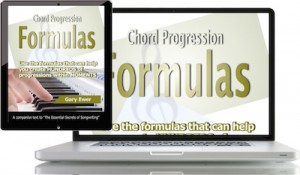It’s an important principle in good songwriting that all elements within any song should act as partners. We know, for example, that the mood of a song can be strongly affected by the tempo we choose, and also by production choices: instrumentation, performance style, and even the key.
A lyric can be excellent, but if it’s not properly supported by the song’s other components, like the melody and chords, it can be ineffective. You might be blaming a song’s problems on a bad lyric, when it might actually be the melody that’s at fault. Good songwriters know this, and they are experts at marrying melody and lyric in powerful and effective ways.
 “Chord Progression Formulas” shows you a system for creating your own progressions in seconds using some basic formulas, in both major or minor keys. It’s available at the Online Store.
“Chord Progression Formulas” shows you a system for creating your own progressions in seconds using some basic formulas, in both major or minor keys. It’s available at the Online Store.
But what about chords? How do you make sure that the chords you’ve chosen are working well with your lyric? And how do you make those choices?
Obviously, whatever chords you choose need to be supporting the melody of the song as its first responsibility, but I believe there is a way to ensure that the chords are also supporting the mood of your lyric.
Here’s one possible way to write that will help to strengthen the bond between lyrics and chords, and make sure that the chords are supporting the mood of your lyrics:
STEP 1: Read your lyric sheet several times, and get a sense of the changing moods as it progresses. This will take time, because each time you read it through, you’ll become aware of subtle shadings of mood that you hadn’t detected before.
STEP 2: Circle any grouping of lines that all seem to convey a particular mood. For example, let’s say you’re working on a verse lyric that goes something like this:

A first read-through would make you think that it’s a kind of despairing lyric from a typical break-up song. But when you look at it a bit closer, you’ll notice that there is a distinct difference between the moods conveyed by the first two lines when compared to lines 3 and 4:

Whatever you choose for chords needs to support this change in mood. But how do you do that?
STEP 3: Improvise short chord progressions that portray some obvious moods. There is a bit of stereotypical choosing here, often determined by your songwriting genre. But let’s assume that you’re doing a basic folk-rock-pop kind of song. You might find that minor-chord progressions will suit a despairing-sad lyric, something like these:
- Am F C G (rpt)
- Am Em Am G (rpt)
- Am Dm C G/B
As you reach the “determination” part of your lyric, you’ll find that progressions that give that sense of hopefulness often use rising bass lines. So choose chords whose roots move upward, like these examples:
- Dm C/E F G
- Am G/B C Dm
- F G Am G/B
It’s probably the work of a PhD student to figure out why we get affected in certain ways by certain chords. It’s rather too simplistic to say that minor chords are sad and major chords are happy. It’s much more involved than that.
And in fact, everyone is influenced in different ways by musical features. A song’s melody can bring tears to the eyes of one person, but leave another person more or less unaffected.
But determining for yourself what moods are displayed by various chord progressions is something you need to learn to be acutely aware of as you improvise progressions. And the first step to bringing chords and lyrics together successfully is to have a clear idea of how the mood of your lyric changes as it progresses.
Once you’ve got a progression that is properly supporting the mood of the lyric, you’ll want to carefully create a melody that is supported by those chords, but also considers the lyric. (If this step is tricky for you, my eBook “Writing A Song From A Chord Progression” will help.
 Written by Gary Ewer. Follow Gary on Twitter
Written by Gary Ewer. Follow Gary on Twitter
Get the eBook Bundle that thousands of songwriters are using to improve their songwriting skills. Learn how to write great melodies, create effective chord progressions, and every other aspect of what makes songs great.
Watch the video below to see more about “The Essential Secrets of Songwriting” 10-eBook Bundle. Right now, it comes with a free copy of “Creative Chord Progressions”











Hi Gary …very useful post I look forward to all your new ones as well .Just wondering why only two progeressions have a (r p t ) next to them .Does it mean repeat ?
Hi Robert: – Oh, no particular reason. I think as I was working them out, I had repeated them as I was improvising over them. In fact, all of those progressions would probably get repeated through a verse or a chorus.
-G
Pingback: Choosing Chords to Make Your Lyrics More Powerful - The Hit Songwriting Formula | The Hit Songwriting Formula